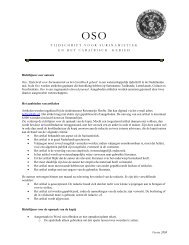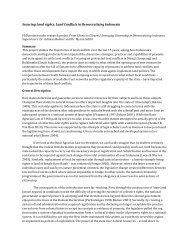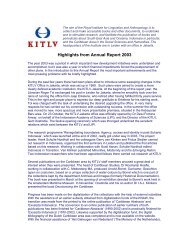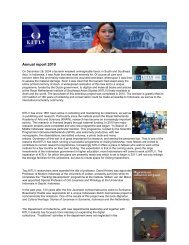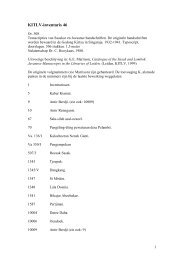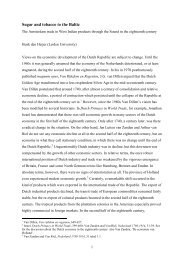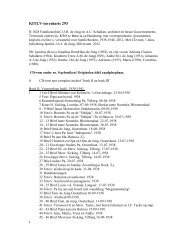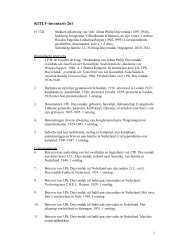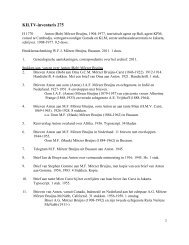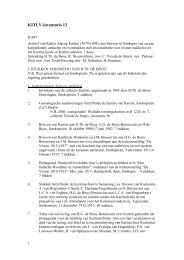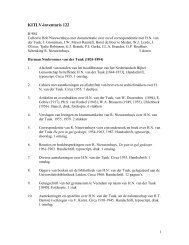indonesian economic decolonization in regional and ... - kitlv
indonesian economic decolonization in regional and ... - kitlv
indonesian economic decolonization in regional and ... - kitlv
You also want an ePaper? Increase the reach of your titles
YUMPU automatically turns print PDFs into web optimized ePapers that Google loves.
Indonesian <strong>economic</strong> <strong>decolonization</strong> <strong>in</strong> <strong>regional</strong> <strong>and</strong> <strong>in</strong>ternational perspective 7<br />
sanctioned discrim<strong>in</strong>ation of non-nationals could be construed as discrim<strong>in</strong>ation<br />
aga<strong>in</strong>st those ethnic Ch<strong>in</strong>ese who had not unambiguously opted for<br />
Indonesian citizenship. The quest for Indonesianisasi offered opportunities<br />
for overt expressions of anti-Ch<strong>in</strong>ese sentiments, as demonstrated by the<br />
Assaat movement <strong>in</strong> 1956 <strong>and</strong> the <strong>in</strong>famous PP 10 (Peraturan Pemer<strong>in</strong>tah,<br />
Government Regulation) <strong>in</strong> 1959, which barred ethnic Ch<strong>in</strong>ese from trad<strong>in</strong>g<br />
<strong>in</strong> the countryside. Some historians, <strong>in</strong>clud<strong>in</strong>g Bambang Purwanto <strong>in</strong> this volume,<br />
therefore tend to equate Indonesianisasi with pribumisasi (from pribumi,<br />
‘<strong>in</strong>digenous’).<br />
Indonesianisasi or pribumisasi was not conf<strong>in</strong>ed to the post-Independence<br />
period. In his contribution to this volume, Peter Post po<strong>in</strong>ts out that <strong>economic</strong><br />
<strong>decolonization</strong> started already <strong>in</strong> the late 1920s, when Japanese <strong>in</strong>vestment<br />
began to enter the Netherl<strong>and</strong>s Indies. A Japan-oriented niche was created <strong>in</strong><br />
the colonial economy that brought pribumi bus<strong>in</strong>ess groups <strong>in</strong> direct contact<br />
with Japanese <strong>in</strong>dustrial capital. Us<strong>in</strong>g the example of one lead<strong>in</strong>g pribumi<br />
entrepreneur of the time, Agoes Moes<strong>in</strong> Dasaad, Post demonstrates that private<br />
<strong>in</strong>digenous bus<strong>in</strong>ess <strong>in</strong>terests managed to <strong>in</strong>fluence <strong>economic</strong> policies to<br />
a significant degree dur<strong>in</strong>g the late 1940s <strong>and</strong> 1950s.<br />
The role of Japan <strong>in</strong> Indonesia’s <strong>economic</strong> <strong>decolonization</strong> was twofold.<br />
Japanese private capital offered unique opportunities for <strong>in</strong>digenous entrepreneurship<br />
dur<strong>in</strong>g both the late colonial period <strong>and</strong> the Japanese occupation<br />
(March 1942-August 1945), which went aga<strong>in</strong>st the very foundations<br />
of the Dutch colonial economy. In addition, as Post emphasizes, substantial<br />
f<strong>in</strong>ancial support from the Japanese government to Indonesia materialized<br />
<strong>in</strong> December 1957, precisely at the time when the Dutch enterprises were<br />
taken over by local labour unions. There is still disagreement <strong>in</strong> the <strong>in</strong>ternational<br />
literature whether or not the Sukarno government was <strong>in</strong>volved <strong>in</strong>, or<br />
<strong>in</strong>formed about, the takeovers beforeh<strong>and</strong> (Gardner 1997; A. Kah<strong>in</strong> <strong>and</strong> G.<br />
Kah<strong>in</strong> 1995). In any case, the government must have felt so strengthened by<br />
the simultaneous agreement on Japanese war reparations <strong>and</strong> long-tem loans<br />
that it retroactively legitimized the actions of labour with great speed.<br />
Indonesianisasi implied competition as well as confrontation. Efforts to<br />
promote Indonesian traders at the expense of Dutch (<strong>and</strong> ethnic Ch<strong>in</strong>ese)<br />
rivals by means of positive discrim<strong>in</strong>ation failed dismally. The Indonesian<br />
government’s attempt to wrest control over <strong>in</strong>terisl<strong>and</strong> shipp<strong>in</strong>g from the<br />
fully Dutch-owned KPM (Kon<strong>in</strong>klijke Paketvaart Maatschappij, Royal Packet<br />
Company) met with a similar fate, as is shown by Daan Marks <strong>in</strong> his application<br />
of an <strong>in</strong>ternational comparative perspective. There is, however, evidence<br />
to the effect that <strong>in</strong>digenous Indonesian bus<strong>in</strong>ess did flourish <strong>in</strong> the 1950s,<br />
possibly even despite policies of positive discrim<strong>in</strong>ation (L<strong>in</strong>dblad 2004).<br />
Confrontations <strong>in</strong> private bus<strong>in</strong>ess became especially <strong>in</strong>tense when<br />
the <strong>in</strong>terests of foreign owners clashed with those of labour, locals or the




